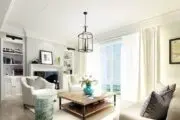
While it’s pretty much a given that your job or your clothes help to define you as a person, it’s less intuitive to think that your living room chair or even your penchant for scented candles could be just as revealing. But those seemingly inconsequential design preferences say a lot more about your personality than you might have thought.
Lindsay Graham, who holds a Ph.D. in personality and social psychology, said that the way we choose to design our homes can reflect who we are and how we want to be perceived by others. In this sense, home decor preferences can have multiple layers of meaning.
“What we know is that literally everything we incorporate into our lives from the kinds of clothes we wear to the kind of music we listen to, even the cities and places where we choose to live, all of that’s been linked to our personalities,” she said.
Graham studies the way we express our identities through our environments at the Center for the Built Environment at the University of California Berkeley. Through her research, she’s explored how this expression extends into our home decor choices.
“When we choose a loud pattern, we’re trying to incite something. Maybe we’re trying to say ‘hey, I’m a fun person, I’m somebody who likes lots of stimulation and to be spontaneous and exciting.’ But it also means you want to just spark that feeling of excitement and that feeling of cheerfulness in your home. So it’s not only who you are, but it’s who you want to be,” she explained.
Graham said that the introverted/extroverted binary could be expressed through specific styles or even furniture pieces.
“People who are highly open to experience tend to have distinctive spaces: it’s unconventional, it’s unusual, maybe they’ll have a chair made out of something like an old sewing machine.”
For example, a reading nook with only one chair could signify an introverted personality that craves solitude. On the other hand, a setting with plenty of comfortable seating areas, mood lighting and candles could belong to a more extroverted person who values social interactions and intimacy with others.
“If I value human interaction, I’m going to create a space that invites closeness and comfort. Whereas if I need more solitude or if I value my alone time, then I’m going to design a space that’s reflective of that and I’m going to set the stage for a more solitary life,” she said.
According to Samuel Gosling, Graham’s graduate advisor and the author of Snoop: What Your Stuff Says About You, every aspect of your home is tied to some element of your identity or persona. Through his research at the University of Texas in Austin, Gosling has identified three major markers of home design psychology: identity claims, thought and feeling regulators and behavioural residue.
Identity claims are the things we broadcast out into the world to make a certain statement about our personalities. For example, a plaid pillow in your living room could be an identity claim about your background or your cultural values.
Thought and feeling regulators are items we choose to decorate our space with because of the way they make us think and feel, like a cozy throw blanket or a framed photo of family members. Behavioural residue includes items like books or yoga mats that are in your space because of a certain behaviour you engage in as part of your identity.
Gosling said that items from these categories can be linked to “the big five” personality traits, which are openness to experience, conscientiousness, extraversion, agreeableness and neuroticism. The three traits that were the most pronounced in his research were extraversion, openness to experience and conscientiousness.
“The trait that came through most clearly in our research was the trait known as openness to experience. People who are highly open to experience tend to have distinctive spaces: it’s unconventional, it’s unusual, maybe they’ll have a chair made out of something like an old sewing machine. They also tend to have original art on the walls rather than the same reproductions everyone else has, and they also have a great diversity of books and art and magazines,” he explained.
So how do people develop these traits? Gosling said it’s mostly genetics, but it can also be attributed to your childhood memories, the values of your parents and they way you were raised.
“If someone had been brought up in a very traditional background versus a very open and progressive environment, it will make them less likely to embrace things that are unusual and different and to push boundaries,” he said.

It’s possible that the polarities of modern/traditional, minimalist/busy and neutral/colorful each come with a corresponding set of opposing personality traits. But everything isn’t so cut-and-dry: design preferences are a spectrum, and just as there are opposite extremes of each style, there is a middle ground as well.
Jane Lockhart, founder of Toronto-based design firm Jane Lockhart Interior Design, said that people who gravitate towards this middle ground tend to come with their own set of distinct personality traits and qualities.
“I think that when people do designs that are very neutral, like transitional design, where it’s not modern and it’s not traditional, they’re good peacemakers because they like a little bit of everything. They like to go with the flow, they don’t like to upset things. They don’t have to live in one camp only,” Lockhart said.
Lockhart also said that a lot of our aesthetic preferences have to do with familiarity and associations. For example, if you were always fed cheesecake at your crazy aunt’s home, you’d probably hate cheesecake, but if you ate pizza with your friends every Friday during your childhood, you would associate it with positive thoughts and emotions.
“A lot of it is what you grew up with. Familiarity does two things: you naturally gravitate towards what you’re familiar with. And familiarity breeds contempt, so you’ll say ‘oh my parents had that I don’t want that’,” she said.
Whether you can’t stay away from neutrals, you’re addicted to polka dots, or you just can’t kick that habit of purchasing fuzzy throw blankets (who would want to?!), it’s interesting to think that more often than not, your personal design preferences are attached to a deeper meaning than what meets the eye.






